The United States has selected Boeing as its contractor for the MQ-25 Stingray unmanned aerial tanker.
This article was written by Larry Dickerson, Unmanned Vehicles Analyst, Forecast International. Forecast International is a major provider of ‘Market Intelligence and Consulting in the areas of aerospace, defence, power systems and military electronics’.
Boeing won an $805 million engineering and manufacturing development contract to provide four aircraft. The MQ-25 Stingray will allow for better use of combat strike fighters by extending the range of deployed naval combat aircraft, according to the U.S. Navy.
The programme has seen a series of requirement changes and schedule restructuring that repeatedly pushed back a production start. The Pentagon’s most recent change saw it move away from the UCLASS (Unmanned Carrier-Launched Airborne Surveillance and Strike) system and toward the Carrier-Based Aerial Refuelling System.
The CBARS program aims to rapidly develop an unmanned system to embark on aircraft carriers as part of the carrier air wing (CVW). The CBARS, which is now called the MQ-25 Stingray, will conduct aerial refueling operations and provide an ISR capability.
The first flight from an aircraft carrier’s deck could occur as early as 2019. The MQ-25 might reach Initial Operational Capability before the end of FY26. Each aircraft carrier could receive four to six UCAVs. Once this version enters service, another model could quickly follow – the so-called MQ-25B. This version would include a more robust strike capability. The B model will also offer a higher speed than the original.
In the future, the U.S. Navy could deploy four to six UCAVS on each of its aircraft carriers. The figure could go as high as 12 UCAVs per carrier. Procurement may reach as high as 156 UCAVs over the life of the program.
However, the U.S. might procure only enough UCAVs for those “at sea” and to meet maintenance, training, and spares requirements. A medium procurement objective might be 56 (four per carrier) to 84 (six per carrier) air vehicles.



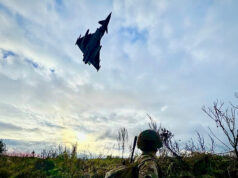
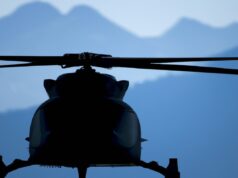
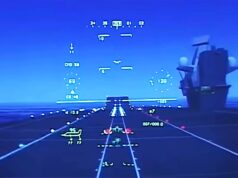
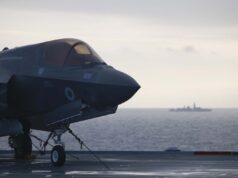

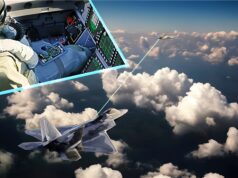
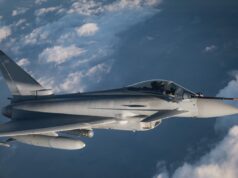
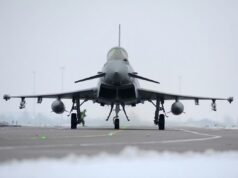
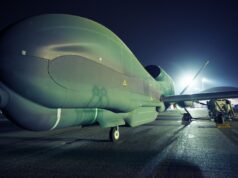


We should be some….oh wait a mo…….
(Chris H) “The United States has selected Boeing as its contractor for the MQ-25 Stingray unmanned aerial tanker”
And a very expensive one @ $200 Mn a throw … but an interesting development and not a missile launcher in sight
What are the general restrictions on the size/configuration of UAVs that QE and POW will be able to handle? Is there any chance that a UAV this size without some sort of near vertical landing mechanism would be able to touch down without plunging off the front end? Would the ski-ramp be sufficient to offset the lack of catapults for take off?
They could potentially have some sort of JATO system or vectored thrust?
It’s interesting. It must be possible to recover some large UAVs on a flight deck the size of QE as well. Wonder what wing configuration and speed would need to look like to get this done with no traps while still being large enough (as well as fast enough on take off) to house enough capability (whatever that may be). Time to be innovative…ScanEagle recovery system comes to mind
The high tech route would be a UCAV of Stingray size, a powerful modified EJ200, utilising a lifting body shape, boundary air blowing, a deflecting exhaust nozzle and a small vertically mounted lift fan
This would be capable of ski jump take offs and relatively slow Rolling vertical Landings.
That’s just to get it on and off the deck, never mind the complex mutual mission systems required….
All technically quite doable, but very, very expensive!
Do you mean something that isn’t a flying jump jet or a giant helicopter (MV-22, Mi-26, or CH-53 size)?
If you mean something fixed wing I would suggest Antonov An-2. The An-2 for all intents and purposes has no stall speed. And work up to being close to QE’s top speed say 25kts. I know they can go quicker but lets say that is a sustainable safe ‘top speed’. A Britten-Norman BN-2 Islander has a stall speed of about 35 kts.
I think using brakes they would stop pretty easily given the length of QEC.
Definitely had fixed wing in mind but nothing else. Just interested to see what is possible (within the realms of physics basically, not economics) to increase capability of the carriers. I’ve seen some on here before arguing that V-22s are out of question for AAR…wonder what else (if anything) might be a more viable option. Thanks for your suggestions. Hadn’t thought of small prop planes before
The main problem with AAR is that the MoD is contracted to use AirTanker assets. If they don’t they incur penalties. When the contract was drawn up it seems nobody thought about organic AAR from the carriers.
For me I am not interested in AAR I was more interested in lofting senses for ASaC and AEW.
I am not sure if there is a need to extend F35b range. And if there were another F35b and tanks would be the best option, but we can’t because of AirTanker.
That’s right, I remember reading about the AirTanker contract restriction…ridiculous (at least on the face of it…wonder what they were thinking). Improved ASaC/AEW would be welcome but at least the capability is covered in part as it stands. I agree with other posters on this site regarding COD…it’ll just be far cheaper for us to carry spare engines in the hangar.
I’m sure the F-35B range is better than the F-18 but extra loiter time would definitely be welcomed by ground forces I’m sure. Shame we are where we are on that front.
Urban myth being regurgitated.
(Chris H) David Taylor – You persist in peddling this falsehood. I have to wonder why but it beats me. There is NO contradiction in the Air Tanker contract for ‘Buddy Up’ refuelling of carrier borne aircraft. Just as UK aircraft can refuel from our another nation’s tankers. As do other nation’s aircraft refuel from our Voyagers. I have taken the time to read the published draft summary of it after your previous attempts to mislead people. I can say you clearly have not.
But I am always open to friendly persuasion so do please quote page, chapter and sub section in that contract that supports your allegations. This should be easy as ‘people like me’ need putting in our place after all don’t they David?
(Chris H) Ross – This is a breath of fresh air. You have read the clause that excludes AAR for carrier borne aircraft? Great! So can you just post it on here and I can then apologise for calling this ‘we can’t refuel F-35s’ idea bullcrap.
Chris, by this…
“…I remember reading about the AirTanker contract restriction…”
…I mean reading about it on this site.
Cheers
I did some research so let’s try to clarify this. My investigations led me to a Freedom of Information request submitted by Chris Revell and replied to by the DE&S Secretariat on 20th Oct 2017. Mr Revell explicitly asked in his questions 1 and 2 about clauses in the contract regarding any non-Airtanker-refuelling fines. (He then asks in his Q3 about whether that influenced RAF A400M decisions wrt AAR.)
The reply is clear….
“From May 2014, the In Service Date for Voyager, the MOD must purchase AAR for UK fixed wing aircraft exclusively from Air Tanker or be liable to pay compensation, as outlined in the contract. However, to date, no compensation has been paid by the MOD. It should be noted that there are exclusions which allow the MOD flexibility to receive AAR from other parties when those aircraft are supporting current operations or joint exercises.”
Here’s the link. Scroll down a bit and click on the attachment (I found “View as HTML” to be the most convenient when viewing in a browser) to see the full text of the MoD response that I quoted from above.
https://www.whatdotheyknow.com/request/airtanker_charges_to_the_ministr
Hope that helps clear this up.
Thanks Julian
An 80 year old Russian biplane refueling F-35Bs.
Yeah that’s the ticket. Tally ho Biggles.
The QE VSTOL option has limited refuelling options drastically, plus other transport/AEW options. Shame really
Aircraft like this are partly why I think it’s inevitable that QE class carriers will eventually have some catapult and arrestor tech retrofitted. They have a 50 year lifespan, it’s almost impossible to imagine them still flying F35s as the sole jet 25 years from now.
It is pretty much certain that they will never have Cats. The carrier would need a substantial increase in power and would have to have a number of decks below the landing deck converted to house the system. It is not impossible but it is not likely. It is more likely that we will have other VSTOL aircraft developed. There is a small chance Arrestor gear could be fitted if you could work out a way to launch the aircraft.
Are you sure about needing more power? I thought the existing turbines provided enough to run 2 EMALS cats. And weren’t they fitted “for not with”? I know they had trouble retrofitting them a few years ago and switched back to a Ski Jump, that was with a still experimental EMALS though. In 25 years EMALS will be mature, possibly have a smaller footprint and be more energy efficient.
(Chris H) For what its worth the power generation available on a QE is more than enough to power EMALS, although EMCATS was more efficient and used less charging power, but basically both use Energy Storage. As General Atomics describes the method:
“The required energy for a launch is drawn from the energy storage device during each two-to three-second launch. The energy storage devices are recharged from the ship’s power between launches.”
So the ship doesn’t need huge power on demand to launch as it feeds the storage devices at a steady rate. Just think very large Capacitors.
As for space the required storage units are not that big for what they do and will certainly reduce in size as they mature. They take up less space than an MT30 as show here under the photo ‘Energy Distribution’:
http://www.ga.com/emals-subsystems
i hope this is of relevance and interest
Thanks.
It was relevant and interesting to me. EMALS in 20-25 years seems a very practical time-frame that would align both with maturity and cost reduction based on Ford carrier class learning and also align with a possible naval platform from the Tempest program along with numerous UAV options. I suspect one of the major reasons why adding CATOBAR back in to the QE carriers was so expensive was because it would have had to be steam powered (or very high risk and expensive if EMALS, assuming it was even an option considered.)
EMALS also aligns with the developments in lower cost, higher energy density storage versus electro-mechanical energy storage systems described in the link and dedicated to EMALS use. For example we already have massive energy delivery capability from electricity grid battery banks today. EMALS wouldn’t need anything like the size of those installations of course and a battery bank has other potential benefits for the ship as an alternative/additional redundancy energy source as well.
Why can’t you imagine a front line jet having a 25 year service life? I can think of a dozen types that have exceeded that.
(Chris H) Ron5 – I am guessing its more about rate of change of the advances in technology making whatever is current redundant rather than the service life of an airframe. After all how old is the F-15 now and still an excellent aircraft but where will aerospace be in 2040 when the QE goes in for mid life refit?
Surely the rate of change of aircraft types in service is slowing down?
The norm is now aircraft having service lives of 40 to 50 years. Not the exception.
Yes, that’s exactly what I’m thinking.
I can think of one that may not?
Have a good weekend ya’ll!
“Uncertainty around expenditure threatens to undermine the economic viability of the F-35, including the UK, which is buying 138 of the Marine Corps version for use on Royal Navy aircraft carriers. The UK MoD is reportedly happy with the overall performance of the aircraft – built to be stealthy and smart, the Joint Strike Fighter incorporates 8 million lines of code – but has questioned whether operating such an expensive and complicated platform represents value for money in the long term.
Stephen Lovegrove, the permanent secretary of the UK MoD, told reporters in March that he’d be discussing the “slightly unknown territory” of future costs in meetings with F-35 programme officials.
Lovegrove summed the problem up thus: “I am constantly being asked by parliamentarians in the UK what the total cost is going to be and they are sometimes, understandably, a bit frustrated when I have to tell them, ‘At the moment nobody is entirely sure’.”
https://www.airforce-technology.com/features/f-35-project/
I can and the F35 may. However the rate of advance over 25 to 30 years is likely to yield aircraft like the MQ25 that are so useful as to make the retrofitting of CATOBAR highly desirable. IMO. Coupled with the likely cost reduction of EMALS over that time period I think it will almost certainly happen.
@ Ron 5
You are being a bit cryptic their Ron aren’t we? Instead of these little acerbic soundbites why not say what you mean? Or are you going to do your normal trick of being a prat then running away as soon as somebody challenges you? Shame this site doesn’t run Disqus you could be switched off and left to rant to yourself.
(Chris H) – same sh*t different day from the guy who abuses folks when he gets challenged
YAAAWWNNN
Funny how you pair always turn up together at the same time.
I have never abused only retaliated.
As I have just said I can see why you oppose systems like Disqus because you won’t be able to go off on these childish tantrums that seem to satisfy you in some odd way.
You can pick any article on this site and find you being rude somewhere in the following comments.
(Chris H) – Nothing funny about it so put away the inferred conspiracy theories. You seem adept at making inferences to fabricate something that doesn’t exist. Its frankly not what this forum is about.
Yes I can be very blunt. But as you can excuse your own rude comments by saying ‘retaliation’ then so can I. And will. Because I prefer to stay on topic and discuss / agree / disagree on the substance. You seem to dislike being challenged and then throw out your ‘Disqus’ fall back line.
David if you can’t take it don’t dish it. Its really simple. And here is a challenge go find ONE comment where I started ANY abuse or rudeness. You won’t find one. And even when the personal row is done and dusted I can still discuss with that person politely about anything else. And have done. Its called adult argument. Google it and learn something.
Although I have received a fair bit of stick for supporting the UK going it alone on Taranis and creating an F35 / Taranis fleet with each F35 controlling 2-4 taranis. This article shows the massive market for such a product.
Time to be brave as a country and create the world beating product I truly believe we can create with Taranis
I humble submit that the RN look at the V22 Osprey for the Refueling role. while looking to the Leonardo AW609 platform for the AWACs role.
V22 AAR has been discussed a lot on this forum. I believe it ended up that it doesn’t have enough fuel capacity to make enough of a difference. It was a F-35B pilot who finally put it to bed on theoretical practical grounds, although budget reality had long since killed it.
I have my doubts given the lowish capacity of the V-33 tanker but it’s a matter of record that the US Marines are planning on using them to fuel their F-35Bs. So not easily dismissed.
F-35B pilots do not comment here or on similar blogs.
* V-22
I have said a number of times that the UK should have pursued Taranis with a view to creating a force multiplier whereby the F35 is in a stand off position jamming and being stealthy and sends in 2-4 Taranis into the danger zone.
Once again our inability to drive home a competitive advantage is lost – as we dick about with the French who are trying to get their inferior engines etc into our product.
If we can turn this around and get some significant funding going – there is still an opportunity and we should perhaps partner with the Japanese and swedes on this and tempest.
I am sure we can get this on and off a carrier if we need to – we are actually really good at this stuff
Agree with your comments in relation to Taranis/Magma, however the F35 requires protection from EA-18G Growlers in order to survive in combat. This has been known for some time as this article clearly shows.
“WASHINGTON: Stealth is being outpaced by software, radar and computing power, so electronic warfare and cyber attacks are growing in importance. While the F-35 may possess excellent — if circumscribed — electronic attack and cyber capabilities, it needs help from the Navy’s EA-18G Growler electronic attack aircraft.
That means, Boeing and the Navy are arguing, that the Navy needs more of the electronic attack versions of the F-18, known as the Growler, to fly with the F-35 on the first day of combat to protect the F-35 and to help protect the service’s precious carrier strike groups.
“The Growlers were highlighted as a priority need by the Chief [of Naval Operations, EW enthusiast Adm. Jonathan Greenert] in his request to Congress. Our assessment is that the DoD needs 50 to 100 additional Growlers, so we will continue to work with Congress to add 22 Growlers to the Fiscal Year 2015 budget and later with the Navy for future Growlers to be inserted into the baseline Fiscal Year 2016 budget in the next cycle,” Mike Gibbons, the Boeing vice president in charge of the F/A-18 and EA -18G programs, said in a statement.
I spoke with an industry source about the assertions we’ve heard from senior Navy and Boeing officials that the F-35 fleet cannot expect to fly its attack mission at the start of a war and survive without help from Growlers.”
https://breakingdefense.com/2014/04/f-35s-stealth-ew-not-enough-so-jsf-and-navy-need-growlers-boeing-says-50-100-more/
HI Nigel
Are you sure about that – my understanding is the F35 is far in advance of the Growlers EW capabilities and offers a significant uptick in capability for the UK.
Happy to be proven wrong – but in the end I am sure we could fit F35’s out with the required kit or even one of the 4 taranis I see being controlled by the F35.
Also gets us out of this argument about radius as the F35 loiters well out of harms way and sends the Taranis/Magma in to do the damage.
TBH I dont see the need for tempest – as UAV’s are the next step whether we like it or not
Japan are looking at purchasing it, not sure why? but it appears to be a very useful asset to any carrier group. Australia are also in the process of upgrading theirs I believe.
https://corporalfrisk.com/tag/ea-18g-growler/
And this could very well be the reason!
“The U.S. Navy’s EA-18G Growler will soon have artificial intelligence on board to give its electronic warfare capabilities a much needed boost.”
https://nationalinterest.org/blog/the-buzz/the-navys-ea-18g-growler-will-soon-be-armed-what-could-be-25704
(Chris H) Pacman27 – It depends how you describe ‘UAV’. At the launch announcement it was stated Tempest is being designed for both piloted and pilotless operation. We will clearly need a piloted Typhoon replacement (QRA, interceptor, GA) and the F-35 will never be able to do that roll especially in ‘B’ configuration so we do need ‘Tempest’ facilitated by maybe a ‘Mk II’ F-35B. Or more likely Tempest supported by later Taranis versions
Building in the option of pilotless operation seems a very good use of limited resources. Whatever we have learned from Taranis / MAGMA will certainly be incorporated into Tempest. We just have to realise we aren’t the USA and we can’t throw $1 Bn buying 4 UAV tankers. They have huge multiplicity / redundancy as they have their Army, Air Force and Navy duplicated by the USMC. And the USMC are nearly the size of UK Armed Forces. It is a level of expenditure a galaxy away from where the UK is. Especially as we have very different social values.
I like this coverage from Janes at the launch although I shouted ‘NOOOO’ at the end when it was suggested the Franco German project could be rolled into Tempest. An idea that would be suicidal for the UK:
https://www.janes.com/article/81926/farnborough-2018-tempest-fighter-jet-launch
Interesting comment about the USMC as they are larger than UK forces and have an audited budget of $26-30bn p.a. Or circa 50% of the UK’s
I do wonder why the UK cant get more out of its budget even if you add £10bn for the RN (inc CASD) and another £5bn for everything else – it is stil clear that the USMC do an awful lot for very little.
We’ve already spent £1bn on Taranis I suspect – time to go all in, we were also at the forefront of Ramjet technology but that also seems to have gone quiet.. its disappointing as without government help I dont think we can compete
I’ve always thought it was shortsighted not to have installed Cats & Traps onboard the carriers from day one which limits their true capability thereby placing all our eggs in one basket if you see my point.
An interesting link was shared by Chris H, please take a moment to read it.
A spokeswoman confirmed that the company is now working with further MoD funding on the development of a larger, more powerful system called EMCAT that may also be used to launch unmanned aircraft.
https://www.theengineer.co.uk/issues/1-june-2009/could-electromagnetic-launch-systems-feature-on-future-carriers/
Managed to find this in relation to Japan.
“On June 12 some Japanese spotters posted photos of two Boeing EA-18G Growlers with Japan Air Self-Defense Force markings. According to a document published by the Japanese defense ministry, the nation is conducting some tests to evaluate a future electronic warfare aircraft.”
https://www.blogbeforeflight.net/2018/06/japan-tests-boeing-ea-18g-growler-electronic-warfare.html
(Chris H) Nigel – As an add – on to your comment on EMCATS this was the system being considered in 2010 as it was more efficient in power terms and had a better delivery rate (faster charging and higher take off weight) than where EMALS was at that time. It was a British design and Converteam were the developing team. The same people who delivered electric drive for all our new ships including QE. A really brilliant team but which is now owned by GE who bought Converteam for $3.2 Bn in 2011 after the MoD went with GA EMALS (another example of the MoD’s standard preference for anything foreign rather than the better British offering). I have posted this link from 2014 before but its worth reading:
https://www.thinkdefence.co.uk/2014/05/whatever-happened-emcat/
As regards the F-35B while I do not share your total negativity over the F-35 I think we agree that our ‘block buy’ method gives us an opt out if it doesn’t deliver what is expected. In the widest spectrum I don’t think it will but for what the UK needs I think it is absolutely the right asset given where we were in 2010 and where we are now. Especially as in overall terms its is actually a nett benefit to the UK economy and not a cost. Carrier strike with a 5th Gen asset and a supersonic Harrier for the RAF in one airframe suits me. Sadly the RAF finally get what they always wanted 50 years after the P1154 was cancelled by dumb politicians enthralled by US Incorporated.
I also believe that given the QEs have been passively engineered for later CATOBAR fit and the progress on EMCATS (and the smaller UAV specific EMKIT) has been excellent I think we will see CATOBAR fitted in the mid life refit. I think the ramp will remain for the ‘B’ and we have the intriguing prospect of a CATOBAR Tempest launching off tracks in the newly painted angled deck and a track in front of the ramp and gaining twice the lift off power. I just hope that the MoD starts thinking more about how WE wish to do things, takes off its Stars & Stripes baseball hats and realises we actually have a better product in EMCATS built here. Albeit one owned by those Stars & Stripes.
Thank you for the update on EMCATS Chris H, another opportunity for the UK to lead out the window!
In relation to the F35B, I believe i’ve provided sufficient information on this forum to make it abundantly clear that relying solely on this aircraft to protect the carriers or be a suitable as a weapons delivery system at a time of war (high tempo) is not even close to being my first choice and that’s providing we can afford to upgrade them to Block4 standards.
Three-quarters of all the F-35 Joint Strike Fighters delivered to foreign customers until 2023 are obsolete and will require major retrofits before they can deliver their promised performance.
An analysis of F-35 contracts awarded to date shows that fully 343 – or 74% — of the 460 export F-35s that Lockheed is to deliver until end 2024 will be in the current, obsolete Low-Rate Initial Production configuration.
“These 343 aircraft are limited both in terms of operational capabilities and of the weapons they can use. They are, and will remain, obsolete because their software is incomplete and because their sensors – designed over 20 years ago – have been overtaken by several generations electronics progress.
They will require substantial — and expensive — upgrades to bring them up to the latest Block 4 standard, after the new sensors and electronics become available in 2023.
The cost of developing and implementing the Block 4 configuration is as yet unknown, and figures have been quoted of between $3.9 billion and as much as $16.4 billion.”
And most importantly for us,
“To our knowledge, European operators of the F-35 also have “overlooked” mentioning the cost of upgrading their older aircraft to Block 4 standard when reporting to their respective Parliaments, to which they will now have to go cap-in-hand to request the necessary funds. One can imagine the welcome they will receive from their lawmakers.
And Block 4 is non-negotiable because unless upgraded, all F-35s delivered before 2023 will be severely limited in their capabilities and will only be able to use very few weapons.”
Lets wait and see!
https://nationalinterest.org/blog/the-buzz/the-navys-ea-18g-growler-will-soon-be-armed-what-could-be-25704
The v 22 is a much better and more feasible option for the UK. It would work best along with drop tank equipped f 35s, refuelling them on the way home when their burn rate is low (the 35s drop their tanks before penetrating the a2ad zone, obviously to be used in a peer war, so air tanker and expense is not an issue) Additionally, it can perform COD, CSAR, SAR, special forces infiltration and exfiltration, and general transport roles, none of which the mq-25 can, plus it doesn’t even look that stealthy with its straight wings.
Also, the v 22 carries about 4/5 as much fuel for tanking as the mq-25, so if it’s impact is negligible then so the mq 25s would be too.
It will all be decided by money. The RN would very much like to acquire a few V-22 but it is extremely unlikely they will be able to secure funding.
There is zero chance that the carriers will be fitted with cats and traps in the future. With squadrons of F-35Bs in UK service by then, there is just insufficient reason to do so. It would be pointless. No UK government is going to spend billions converting the carriers when their main aircraft don’t need cats.
Similarly, there will not be a naval version of any possible Tempest for exactly the same reason there was no naval Typhoon. In no way shape or form, is it economically feasible. Billions in development for a few dozen British only aircraft is nuts.
And we really need to stop this nonsense about the F-35 being obsolete or near obsolete. That is an absolute crock that nobody in the RN or RAF subscribe to. Those folk want more, delivered faster. Putin is scared of the F-35 which is why his bots and websites spend so much time trashing it.
Are you saying Ron5 that the DOT&E, DOD, the Pentagon and senior US military officials along with respected US defence websites including Bloomberg and of course Pierre Sprey the co-designer of the F15, F16 and A10 are in fact Russian websites and bots?
I believe he described it as a Lemon if my memory serves me correctly? Jack of all trades and master of none as we say here in the UK.
Apologies Ron5, he describes it as a Turkey.
https://www.youtube.com/watch?time_continue=4&v=mxDSiwqM2nw
Sprey is an out of date, intellectually dishonest idiot, not a Russian troll. He wants f16as, not even late block cs to replace the f 35. Any air force that did this would be shot out of the sky.
Oh and the co designer of the 15 and 16 wouldn’t be a tiny bit jealous? I’ve seen the interview, to be honest he seems to be stuck in 20 century and seems to struggle with cyber concepts, he may be wicked at plane design but seems to be stuck in past.
The f35 isn’t about dog fighting, but tech, breaking enemy kill chain and it’s the future.
Just god help us if it doesn’t work.
(Chris H) Ron5 – the only area I would gently disagree with all that is about a naval Tempest. It is a blind alley to say ‘Typhoon cost too much so Tempest will’ for the simple reason there was no reason to design in naval capability in a version of Typhoon once the French left. Where the excessive costs came about was with the Indians wanting a possible naval version and BAE trying to deliver one against the Rafale M an already proven naval asset. To redesign, test and develop an airframe from one specification to another is where the costs come in. Its basically impossible.
Tempest will, I have no doubt, have CATOBAR capability designed in from Day One so the extra costs will be negligible. For no other reason the aircraft will need to appeal to as wide a market as possible and its delivery date is too close to QEs first major refit to be ignored. Likewise by 2035 the UK Converteam EMCATS / EMKIT catapults will be very advanced in development (as will the General Automics EMALS). So all the component parts are all there. Just like the component parts for a Tempest prototype are already there.
While I think the F-35B has been and will be the right asset at the right time for what both the RN and RAF need for the next 25 years I am not convinced about the F-35A. The ‘C’ has an obvious purpose (if limited market) but the ‘A’? On the wider spectrum the F-35 programme still has too many unanswered questions right now although I don’t share Nigel’s belief it is a total disaster either.
Nope.
Chris H, I’ve never said its a total disaster but simply pointed out the many shortcomings the F35 programme has right now and the predicted time it is going to take to fix the ones we know about at the time of writing.
The cost to fix these could greatly increase especially the upgrade to Block 4. If 2025/6 is the date we can expect this aircraft to be of any real use to us, then in my opinion it’s too little to late and we should be spending our budget upgrading the Typhoon fleet to include thrust vectoring, more powerful engines etc and of course Tempest and Taranis.
It might also be advantageous to look at the latest EA-18G Growlers and include a squadron of these as well. Or could Typhoon perform this role adequately as well?
Apologies for the grammar, building work taking place here at the moment so i’m torn between the two!
There are always initial shortcomings in all advanced military programs. Typhoon is still not able to use Brimstone for instance…
The F35 program is no different from any other in this respect.
Brimstone is on track and not due to enter service until 2019 as planned.
“The new variation is being developed through the Brimstone 2 Capability Sustainment Programme will replace all earlier variants in 2022 and have an upgraded seeker, rocket motor, warhead and guidance system, making it an even more effective weapon.
The new missile will arm Typhoon when it takes over as the RAF’s principal ground-attack aircraft in 2019.”
https://ukdefencejournal.org.uk/successful-live-firing-brimstone-missile-typhoon/
@Nigel Collins
Lol… “On Track”. The missile has been in service for a long time and is only just getting to operational status on the Typhoon. If I gave myself that sort of leeway on the projects I work on then I could always claim everything was on track.
All systems take time to integrate. The F35 is operationally ready as has already been seen. It will get better over time just like Typhoon has with its upgrades.
This is probably a silly question but would it be possible to keep the tamp on QE and have a EMCAT/EMALS rail running up it i.e. following the curve of the ramp? Surely by not only chucking the aircraft off the ship by the catapult but adding the additional lift generated from the ramp should enable an increase to the aircraft’s payload. I wonder if anyone has investigated this route?
Sorry, really need an edit function post “posting”.
Easier to make the cat either longer or more powerful.
I agree with Ron. Any cat is putting much more energy into the aircraft while it still has its wheels touching the deck than engines alone do, that’s the whole point of having the cat, so with all that extra energy in the aircraft by the time it gets to the ramp I’d be very concerned about the forces on the nose wheel. The F-35C already has stronger nose gear to handle the horizontal pull of the cat but that is extra strength to withstand purely horizontal forces (and torque). In the scenario you imagine the force on the nose wheel would also have a significant vertical component when it gets onto the ramp and that could get pretty challenging especially when they are trying to keep weight on the unloaded aircraft as low as they can. Which all leads to Ron’s conclusion, better to load the cost and engineering onto the one-time hit of a longer and/or more powerful cat on the ship than needing far heavier and more complex nose gear on every aircraft. And it’s not just the nose gear by the way, the under-wing gear would also be subject to extra vertical force that they are not currently designed to handle.
Impressive piece of kit. Which was in the works in various guise when we were fucking about trying to decide whether we should have cats and traps or not. How short sighted can we continue to be?!
Osprey is our only answer at the moment for A2A refueling for the F35
Could they not just buddy a couple of tank laden F-35’s up with the strike flight and air-to-air close to the carrier? How much fuel would that transfer??